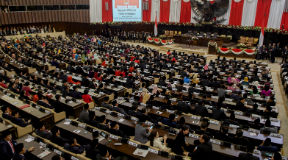
Crisis management Standard Operating Procedure (SOP) must be clear and concise, make sure you have a crisis management team, carry out simulations. Photo: Roni/PR Indonesia
A disaster crisis cannot be equated with any other crisis that occurs in a company. However, strategic crisis management measures in companies can be applied during a disaster crisis.
This difference has been underlined by Noke Kiroyan, President Commissioner of Kiroyan Partners, at the beginning of the interview with PR INDONESIA at his office in Jakarta, Thursday (11/10/2018). “The method of crisis handling in a company can be used. It’s a matter of management,” he said.
Basically, neither a crisis in the company nor a natural disaster could be predicted when it would come, said the man who was born in Surabaya, 71 years ago. However, it can be predicted potentially and there must be preparedness so as not to confuse when the crisis occurs.
The method Noke refers to is a procedure that refers to the crisis management standard operating procedure (SOP). SOPs should be clear and concise. In times of crisis, make sure you have a crisis management team. Don’t forget to conduct a simulation (role play). “It is important to create one not only when it is happening. Otherwhise, it’ll be chaotic,” he said.
Although he recommended that a complete team should be formed, including appointing a spokesperson, Noke emphasized that the highest leadership (of the company) should not be part of the team. “It should be enough to involve senior team members who have lower authority in the team. Later, the person concerned has to report to the highest leadership,” he said.
Another thing to do post-crisis is to keep a journal about what happened. This journal could be used for the team to conduct analysis and determine appropriate countermeasures.
Factual
Make sure that the information conveyed to the public is factual, concise, not verbose, speculating, let alone lying. “If the disaster involves human lives, convey the estimated number of victims equipped with supporting data, and convey the first steps that have been taken by the government,” he said.
Meanwhile, to avoid hoaxes and fake news, make sure the PR or crisis management team provides factual information on a regular and ongoing basis. “Prove that we can become a good center for information by showing that we are willing and ready to be contacted at any time. Provide a contact number, and if necessary, a contact center,“ he said.
Regarding efforts to rebuild a post-crisis reputation, it is similar to building trust. For this reason, information about the analysis, the efforts that have been made, and the steps that must be taken so that the incident does not recur, must be communicated properly to the public.
“Make sure the message arrives. Show the steps that have been taken that lead to improvements starting from before, during and after consistently,” he added. Conduct a survey on public perceptions of the company after the crisis. Use the results to perfect an existing plan, create a reputation-building program or strategy. “Don’t make assumptions,” he pleaded.
Thus, for companies, let alone the government, that do not yet have SOPs, this is the time. Crisis in companies can occur due to negligence, but not with natural disasters. “So, when a disaster occurs, there is no one to blame. What’s wrong is if we are not ready,” he concluded, firmly.
Noke Kiroyan
Chairman & Chief Consultant, Kiroyan Partners
This article has been published in PR Indonesia magazine 43rd Edition, issued on October 2018, page 12.
Download the clipping here.



